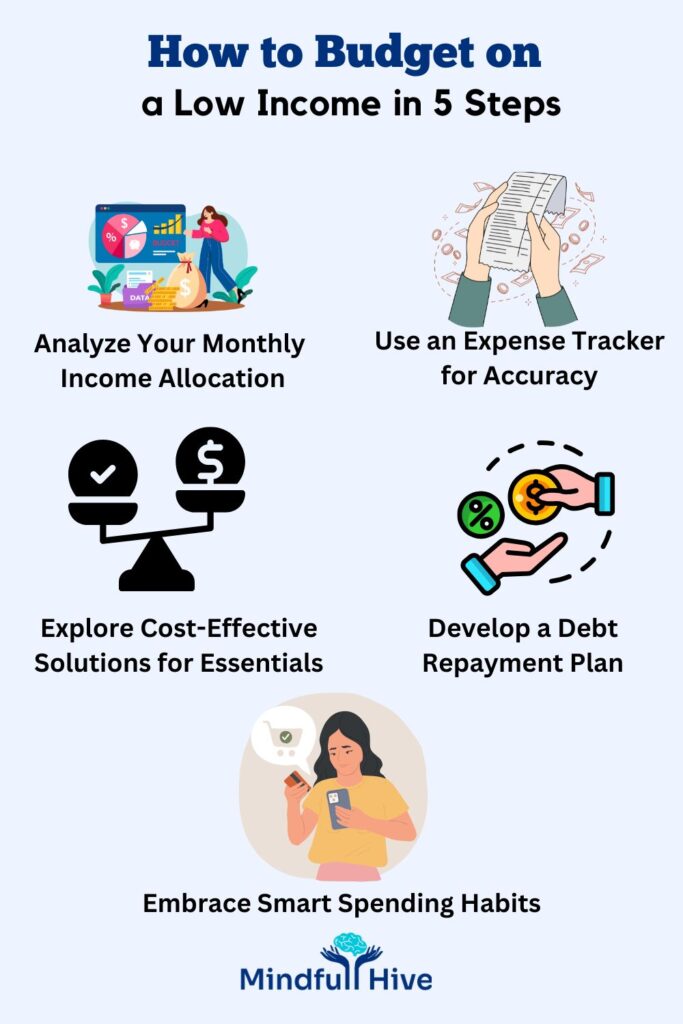If you’re wondering how to budget on a low income, start by creating a budgeting worksheet to detail your necessary expenses—like rent, utilities, and groceries—versus your actual monthly income. Then, set aside even a small amount for low-income savings. Following these steps helps ensure financial stability without sacrificing all the little joys in life.
I’m a 25-year-old woman who once juggled two part-time jobs while struggling to pay college tuition, rent, and the occasional medical bill. I know the overwhelming feeling that comes with a low paycheck: it can be frustrating to figure out how to manage money with low income. But over time, I discovered cost-effective solutions, money-saving hacks, and smart spending habits that helped me stay on top of my finances. In this personal guide, I’ll share personal finance tips you can use to develop a low-income budgeting plan. By the end, you’ll see that saving money on a tight budget and reaching your financial stability goals is possible.
Whether you’re curious about how to save money fast on a low income or how to finally tackle your monthly expenses in a structured, less stressful way, this post will walk you through the most practical steps to thrive. Let’s dive in!
Understanding the Basics of Low-Income Budgeting
Why Budgeting Matters
I’ll never forget the first month I truly sat down and wrote out all my expenses. Up until then, I’d tried to “wing it,” hoping I’d have enough money left at the end of the month. But a budgeting worksheet changed everything for me. Why?
- Clarity: It reveals exactly where each dollar is going.
- Control: You can identify problem areas—like impulse spending or overpriced subscriptions.
- Motivation: Seeing a path toward low-income savings or emergency fund savings can boost your morale and keep you disciplined.
If you’re aiming for financial stability, a structured budget will serve as your roadmap. It also helps when considering a debt repayment plan, as you’ll clearly see how much you can allocate toward reducing credit card or student loan balances each month.
Key Components of a Budgeting Worksheet
A budgeting worksheet doesn’t have to be fancy. It can be a simple spreadsheet, a handwritten table in a notebook, or even a phone app. The key sections include:
- Monthly Income Allocation: Document your income sources (e.g., salary, side hustle, child support) so you know exactly how much you have to work with.
- Fixed Expenses: Rent or mortgage, utilities, insurance, and loan payments.
- Variable Expenses: Groceries, gas, phone bills, and other costs that fluctuate.
- Savings and Debt Repayment: The portion you set aside for low-income savings and any debt repayment plan.
- Wants or Discretionary Spending: Entertainment, dining out, hobbies.
By breaking down the categories, you’re effectively engaging in smart financial planning—the bedrock for anyone interested in how to budget money on low income or looking for budgeting tips for low-income families.
Implementing a Practical Low-Income Budgeting Plan
Now that we’ve covered the basics, it’s time to apply these principles. Here’s my 7-step low-income budgeting plan that helped me transition from living paycheck to paycheck to finding a bit of breathing room each month.

Step 1 – Analyze Your Monthly Income Allocation
- List All Income Sources: Start by listing everything that brings money in, no matter how small. This includes your regular job, side gigs like freelance work, babysitting, or selling handmade crafts online.
- Estimate a Realistic Total: If your income fluctuates, take an average of the last 3-6 months.
Why It’s Important:
Understanding your monthly income allocation sets the framework for your entire budgeting worksheet. If you’re inconsistent, you might underestimate or overestimate, which can lead to mismanaged finances. Precisely knowing how much you earn is critical for how to budget and save money on a small income.
Step 2 – Use an Expense Tracker for Accuracy
Let me be honest: the moment I started using an expense tracker, I realized I was overspending on coffee and late-night fast-food runs. An expense tracker can be:
- A phone app (many free options exist).
- A spreadsheet you update daily.
- A simple pen-and-paper log of every purchase.
How It Helps:
- Accountability: You become more aware of your spending.
- Identifying Patterns: Recognize overspending categories.
- Easy Adjustments: Once you see where money leaks occur, you can deploy cost-cutting techniques immediately.
Consider this a central tool if you’re serious about how to save money with low income, because it ensures no penny goes unaccounted for.
Step 3 –Explore Cost-Effective Solutions for Essentials
When you’re saving money on a tight budget, it’s crucial to keep day-to-day living costs as low as possible. Through trial and error, I found multiple cost-effective solutions that didn’t hurt my quality of life:
- Meal Planning: Prepping meals in batches can significantly reduce grocery bills.
- Energy-Saving Hacks: Unplugging unused electronics, sealing window drafts, and using energy-efficient bulbs.
- Shared Accommodation or Roommates: Splitting rent and utilities can drastically cut monthly expenses.
Comparison Table: Different Cost-Effective Strategies
| Strategy | Pros | Cons |
|---|---|---|
| Meal Prep | Saves time & money; reduces food waste | Requires planning & bulk cooking |
| Public Transport | Cuts down fuel costs; eco-friendly | Less flexibility in schedule |
| Negotiating Bills | Lower monthly rates, especially for phone & internet | Time-consuming process |
| Buying Generic Brands | Cheaper than brand names | Perception of lower quality (often not true) |
Adopting even a few of these approaches can lead to low-income savings because every dollar not spent is a dollar earned.
Step 4 – Develop a Debt Repayment Plan
If you have any outstanding debt—be it credit cards, medical bills, or student loans—a debt repayment plan is essential. Here’s how I approached mine:
- List All Debts: Note down balances, interest rates, and minimum payments.
- Prioritize High-Interest Debts: Focus on clearing those first to reduce interest charges over time.
- Set Monthly Targets: Allocate a fixed amount in your budgeting worksheet specifically for debt repayment.
Pro Tip:
- Use the “snowball” or “avalanche” method. The snowball method pays off the smallest balances first, giving you morale boosts. The avalanche method tackles the highest interest first, saving you more in the long run.
Why It Matters:
Paying off debt more aggressively helps you ultimately redirect funds toward low-income savings and other long-term goals like investing or homeownership.
Step 5 – Embrace Smart Spending Habits
Before adopting smart spending habits, I frequently bought things on impulse—like trendy clothing, subscription boxes, or random gadgets. The shift to mindful purchasing was a game-changer:
- Set a 24-Hour Rule: If you’re tempted to buy something that isn’t a necessity, wait 24 hours. Often, you’ll realize you don’t actually need it.
- Compare Prices: With countless online platforms, it’s easy to compare prices and snag the best deal.
- Buy Secondhand: Thrift stores, online marketplaces, or garage sales can be goldmines for quality items at a fraction of the cost.
Developing smart spending habits is critical for those who want to know how to budget money on low income effectively. Small daily choices add up to bigger monthly benefits.
Step 6 – Focus on Low-Income Savings and Emergency Fund
You might think saving is impossible on a low income, but every small contribution counts. Even if you can set aside $5 or $10 a week, you’re actively building low-income savings. Here’s what helped me:
- Automated Transfers: Schedule a portion of each paycheck to automatically go into a savings account.
- Emergency Fund First: Aim for 3-6 months’ worth of essential expenses. This emergency fund savings can protect you when the unexpected happens (car repairs, medical emergencies, or sudden unemployment).
- “Round Up” Apps: Some banks or apps offer the option to round up each purchase to the nearest dollar, depositing the difference into your savings.
Over time, you’ll watch your low-income savings grow, granting a sense of security and financial stability. Trust me, the peace of mind alone is worth it.
Step 7 – Revisit and Revise Your Budgeting Worksheet Regularly
Life changes—salaries fluctuate, new expenses pop up, and old ones disappear. I recommend reviewing your budgeting worksheet at least once a month:
- Check for Overlooked Categories: Did you add a new subscription you forgot to note?
- Assess Debt Repayment Progress: Are you hitting your monthly targets for your debt repayment plan?
- Adjust Savings Goals: As your monthly income allocation changes, you may be able to increase contributions to your low-income savings.
This consistent evaluation ensures you’re always prepared for the month ahead, solidifying your financial stability over time.
A Personal Anecdote: My Turning Point
I used to dread looking at my bank account because the numbers were never what I hoped. But after implementing these seven steps, my anxiety around money began to fade. I remember the first month I had $300 saved—that was a huge milestone for me. It took discipline, using an expense tracker, and focusing on cost-effective solutions, but the payoff was incredible.
Suddenly, I felt less stressed about unexpected bills, and I could occasionally treat myself to small pleasures—like a coffee date with friends—without guilt. This personal victory showed me that it’s entirely possible to save money on a tight budget and even tackle bigger dreams, like eventually buying a used car or planning a modest vacation.
5 Essential Frugal Budgeting Strategies
- Batch Cooking & Freezing: Prepare large meals on weekends and freeze portions for busy weekdays.
- Library Over Netflix: Borrow books, movies, or games from the library instead of paying multiple streaming subscriptions.
- Carpool or Bike to Work: Save on gas, parking fees, and vehicle wear-and-tear.
- Buy Generic & Store Brands: Often just as good as name brands, but significantly cheaper.
- Cash Envelope System: Assign envelopes for different budget categories. Once the cash is gone, no more spending in that category until next month.
Cost-Cutting Techniques at a Glance
- Negotiate Utility Bills: Call providers to see if they offer reduced rates or payment plans.
- Shop Sales & Clearance Racks: Avoid full price when possible.
- DIY Cleaning Supplies: Vinegar, baking soda, and lemon can do wonders.
- Plan Holidays in Advance: Book flights and accommodations during off-peak times.
- Use Community Resources: Food banks, clothing swaps, and local charities can help temporarily.
Popular Budgeting Methods
Below is a quick look at different budgeting methods I’ve tried and what I found best for low-income budgeting:
| Budgeting Method | How It Works | Ideal For |
|---|---|---|
| Envelope System | Put physical cash in envelopes for each category; when it’s gone, it’s gone. | People who overspend easily |
| Zero-Based Budget | Income minus expenses equals zero; every dollar is assigned a job. | Those wanting a highly detailed plan |
| 50/30/20 Rule | 50% for needs, 30% for wants, 20% for savings. | People with more consistent incomes |
| Percentage Split | Decide personal percentages for each category (e.g., 40% needs, 20% wants, 20% debt, 20% savings). |
Individuals wanting flexibility |
My Take: For how to budget money on low income, the envelope system can be extremely helpful because it limits overspending. However, a zero-based budget offers the most clarity if you’re detail-oriented.
5 FAQ (Frequently Asked Questions)
1. How to save money fast on a low income when my expenses are already high?
Start by tracking every purchase with an expense tracker. Then, reduce or eliminate non-essentials (like subscriptions or dining out). Automate a small sum—like $10—into a savings account each paycheck. Little by little, it adds up.
2. What if I have irregular income and can’t set a fixed budget?
If your income fluctuates, average the past 3-6 months to get a baseline monthly figure. Use that number for your monthly income allocation. In busier months (when you earn more), increase your low-income savings or pay extra towards your debt repayment plan.
3. Are there any government programs for low-income families?
Yes, many regions have assistance programs covering housing, food stamps (SNAP), or utility discounts. Budgeting tips for low-income families often include leveraging these resources to free up more room in your budgeting worksheet.
4. How do I stay motivated when progress feels slow?
Set small milestones (like saving your first $50, then $100) and celebrate each achievement. Remember why you’re doing this—to gain financial stability and reduce stress. Keeping the bigger picture in mind helps during tough moments.
5. Should I focus on saving or paying off debt first?
Ideally, build a small emergency fund savings of at least $500-$1,000, so unexpected bills don’t derail you. After that, prioritize your debt repayment plan (especially high-interest debt) while continuing to save modestly if possible.
2 Quick Tips
- Quick Tip #1: Use a free online budgeting worksheet template to kickstart your journey. Most are customizable and guide you on what categories to include.
- Quick Tip #2: Set aside time every Sunday to review your expense tracker for the week. Adjust or plan for the following week accordingly. Consistency is the secret to financial stability.
Putting It All Together: A Personal Note
Living on a modest paycheck doesn’t have to mean perpetual struggle. As someone who’s navigated the uncertainties of a low income, I can vouch for the transformative power of a budgeting worksheet, consistent tracking, and unwavering determination.
Yes, it takes discipline, and no, the journey isn’t always fun. However, once you start seeing the fruits of your labor—like having funds for an emergency, paying off debt faster than expected, or enjoying a small treat without guilt—you’ll realize every penny saved and every careful decision made is worth it. These personal finance tips aren’t just theories; they’re real-world-tested methods I’ve personally benefited from.
If you commit to even half of the cost-effective solutions, money-saving hacks, and smart spending habits outlined here, you’ll be well on your way to mastering how to budget and save money on a small income. In time, your low-income savings will grow, your debt repayment plan will shrink, and you’ll achieve the financial stability you deserve.
I hope my experiences resonate with you and inspire your own budgeting journey. Remember, every dollar counts, and small steps lead to significant progress. You have the power to take control of your finances—one choice at a time.











